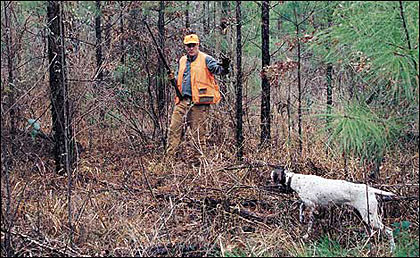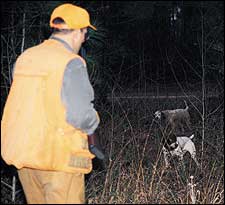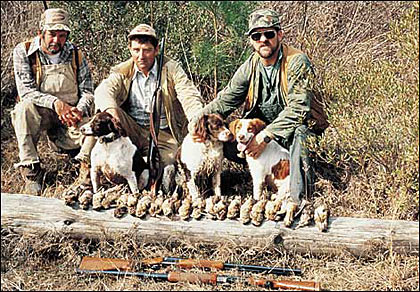Public lands in East Texas offer excellent woodcock hunting
By Henry Chappell
 Molly was somewhat tentative on this East Texas piney-woods point. Even woodcock can sometimes shuffle off. Molly soon moved ahead and nailed her bird. |
My strategy seemed sound enough. I'd walk along the nice, open fire break while my German shorthair, Molly, worked the tangles just inside the edge of the young longleaf pine plantation. The soft January drizzle settled on my glasses. The night before, a steady night rain had softened the loam making it perfect for a probing woodcock.
Sure enough, within minutes Molly's beeper collar went off. I pulled my cap down tight and with a gloved hand, pared an opening in the wall of briars. Within seconds I was stuck; pine boughs dumped streams of cold water down the back of my neck; I cursed my lightweight brush pants.
I ripped free and picked another route. Then another. The beeping sounded more urgent by the second. I assured Molly that I was on my way. I nearly fell on her before I saw her. Her eyes bulged, but not at the sight of me. There in plain sight, two feet in front of her nose, sat a woodcock hen. I took another step; the bird flew and to my utter amazement, I broke my lifelong streak of missing game birds I had seen on the ground before the flush. Accidents happen.
I missed the next three.
Most years, migrating woodcock begin dropping into East Texas coverts in November. Peak buildup occurs in late December or January depending on the weather. Tough winters in the Midwest mean good hunting in East Texas--good hunting that's largely ignored by Texans who stay busy with quail and waterfowl.
"Woodcock are a very underutilized resource," says Wildlife Program Leader Jay Roberson of the Texas Parks & Wildlife Department. According to Roberson, only a few thousand Texas hunters bother with woodcock and most of those hunt only two days per season. A harvest of 5,000 birds constitutes a big year. I've been hunting East Texas woodcock since the early 1990s, and I've never met another woodcock hunter in the woods. I've met very few Texans who know what a woodcock is.
Although most central flyway woodcock winter in Louisiana's Atchafalaya Basin, a good number spill into East Texas. A few birds winter as far east as Dallas, and there are reports of woodcock as far west as Abilene. Most of the birds light in the Pineywoods ecological region--16 million acres of second and third growth upland pine and hardwood creek bottoms in the far eastern part of the state. Here, the forest management practices of small-scale clearcutting, thinning and burning create ideal woodcock habitat.
 Woodcock can often be found even in the open woods, especially early and late in the day. Here, Molly and Buck prove the point. |
For years, I considered the woodcock a backup bird, something to hunt while suffering through Texas' infamous bobwhite busts. After spending November and December running my dogs into the ground chasing a few unapproachable, drought-honed West Texas coveys, my buddies Brad Carter and Jay Chesley and I would head for the "piney woods" for a few days of stumbling around briar-infested pine plantations.
My old shorthair, Heidi, loved woodcock and had a knack for finding them smack in the middle of 60 acres of briars and head-high pine. I'd sweat and cuss my way toward the sound of her beeper collar, thinking all the way about Gene Hill's woodcock stories and the alleged existence of hillside apple orchard covers and perfect alder bottoms. I'd look at the rapidly disappearing finish on my Beretta and think about carrying a carrying a Greener or L.C. Smith into the standard East Texas thicket. On my first serious woodcock foray, I completely destroyed the shell loops on the front of my vest.
We had some good trips and found plenty of woodcock. On the best days, we flushed 20 or more, although we usually heard far more birds than we actually saw, let alone shot. Best of all, we had real camps. We felt like we were on vacation. Tent-camping in West Texas' bobwhite country is strictly a matter of cost and convenience. You do it to save money and to be near the hunting. The near constant wind mangles tent poles and nerves, blows cooking gear off of tailgates and, if you're not careful, will transform your campfire into a 10,000-acre conflagration. But in the sheltered piney woods, we'd pick a secluded spot in the Davy Crockett or Angelina National forest and set up an elaborate campsite complete with a tarp covered kitchen and pig-size fire pit. No hunkering with the Coleman stove behind the dog trailer. No chasing paper plates across pastures. No staggering out in the middle of the night to tighten slipped tent guy lines.
We'd get in just before dark, after several hours of chasing big running quail dogs through briar jungles, tend to our wounds and jangled nerves, down a few cans of chili and sit around the fire until midnight. Next morning, we'd eat ourselves into a stupor and consider the hellish woodcock thickets. Then, likely as not, we'd pour ourselves another cup of coffee and consider them some more. If we were particularly ambitious, we'd be in the briars by 9:30 a.m. We joked a lot about going camping and shooting a few woodcock while we were at it.
Then, few years ago, I met Dr. Monte Whiting. Monte is a professor of wildlife management at Stephen F. Austin University in Nacogdoches and one of South's foremost woodcock authorities. Most years he'll take more than a hundred birds. Over the past 10 years, I've taken exactly one five-bird limit of woodcock, and I did it in about two hours of hunting with Monty and Temple Inland biologist Don Dietz. We moved between 30 and 40 woodcock, all of them in the open pine woods. No hellish thickets; no briar-torn hide. I was flabbergasted.
Why would cover loving woodcock be in the open woods where they're vulnerable to avian predators? Monte believes that during particularly dry winters, the ground in young pine plantations and clearcuts becomes too dry and hard for the birds to probe. On the other hand, the duff on the floor of the mature woods retains moisture and remains relatively soft even during times of drought. And, contrary to conventional wisdom, woodcock don't always feed by probing. From his deer stand in the big woods, Monte has often watched a woodcock scratching in the duff like a wood thrush.
Even during moist years, hunters rarely need to fight the densest thickets. U.S. Fish and Wildlife Service Biologist Jeff Reid, an avid Texas woodcock hunter, recommends hunting the edges of recently cut or thinned areas. "Near the end of legal shooting ho
urs, the birds come right to the edges. Those thick spots are full of birds, but I don't let my dog go in there because you can hardly shoot. If someone were coming to East Texas for the first time, I would tell them to walk the old woods roads and plowed fire lines around these cuts. The dogs will cover more ground, and they'll pick up birds here and there."
Brad Carter and I did just that on a hunt this past January. Molly and Brad's setter, Buck, found most of the birds in the brambles just inside a young pine plantation while Brad and I strolled along the surrounding fire break. The dogs rarely pointed beyond 15 or 20 yards into the plantation. Many of the birds flew out of the heavy cover and into the adjacent big woods. Had Brad been carrying a shotgun instead of his camera, he could have taken an easy limit by standing in the open while I flushed the birds. Late in the day, we flushed several woodcock in the middle of the firebreak.
At times, though, the birds can be found only in heavy cover. This is especially true during the middle of the day. Woodcock need dense, low overhead cover for protection from raptors and open space at ground level for easy movement and foraging. Although the birds feed heavily at night in fallow fields and new clearcuts, bore holes are common even in the acidic, needle-strewn soil beneath thick stands of young pines.
Monte recommends that hunters concentrate on three- to five-year-old pine plantations and other early successional areas. These can be clearcuts or "beetle spots"--areas thinned to control southern pine beetle infestation. "Look for lots of blackberry, southern wax myrtle, eastern baccharis and sandy loam soils," he says. "Early and late in the day are usually good, but you can just about forget it on a hot, dry afternoon."
I wear a heavy long-sleeved shirt and brush pants and gloves regardless of the temperature, and it's often quite warm. I do more damage to my hunting clothes (and hide) on one East Texas hunt than on years of West Texas quail hunts. Eye protection is a must. And I wouldn't step into a big thicket without a compass. Two minutes among the high pines and my sense of direction is completely gone. The pin-on style compasses are especially handy.
 Good "doodle" habitat can produce, as these East Texas woodcock hunters have proven. |
Molly wears both a bell and a beeper collar operated in the point-only mode. The bell makes tracking her easy, and I'm spared the annoying beep until she goes on point. Close working dogs are ideal, but the heavy cover tends to slow even hard chargers. Molly often ranges to 250 yards on the plains, but in piney woods coverts, she rarely works more than 50 yards out.
Despite the briars, East Texas seems easier on dogs than the West Texas rangeland. There are no sand burrs, hence no need for dog boots and duct tape. And no high-speed collisions with prickly pear cactus and cholla. But the wood ticks are horrible. I keep Molly's Lyme disease booster up to date and douse her with tick repellent.
According to singing ground surveys, woodcock numbers have declined at a rate of about two percent per year since 1968. Two years ago the Texas woodcock season was shortened from 60 days to 45 days, and the bag limit was reduced from five birds to three.
| ADDITIONAL INFORMATION | 
 |

Four East Texas wildlife management areas offer excellent woodcock hunting: the Moore Plantation WMA in the Sabine National Forest, the Alabama Creek WMA in the Davy Crockett National Forest, the Bannister WMA in the Angelina National Forest and the Sam Houston National Forest WMA. Forest Service land outside of the management areas provide excellent hunting as well.
The Texas woodcock season typically runs from mid-December through January. Recent bag limits were three per day, six in possession. The public areas are used heavily by deer hunters, especially on weekends. Deer season typically runs through the first weekend in January.
For more details on hunting regulations and public hunting opportunities, contact the Texas Parks and Wildlife Department, 4200 Smith School Road, Austin, TX 78744; 800/792-1112; www.tpwd.state.tx.us.
For maps and information on hunting in the large National Forests in Texas, contact the U.S. Department of Agriculture Forest Service, Homer Garrison Federal Building, 701 North First Street, Lufkin, TX 75091-3088; 409/639-8501.
|
|
A number of Southern biologists, including Monte, suspect that woodcock are faring slightly better than the surveys indicate. "I believe we've had a shift in breeding area in the past 30 to 40 years," he says. "The Northern habitat is not as ideal as it once was, whereas in the South it's much better due to logging practices. Right now, the Fish and Wildlife Service doesn't consider the South in their breeding surveys, even though we're creating some gorgeous nesting habitat down here. Courtship usually begins in January, and we have full clutches on the ground in February." Monte and his students have spent hundreds of hours in the Pineywoods locating nests and documenting the male woodcock's courtship display.
Monte recently received funding from the U.S. Fish and Wildlife Service to locate nests and band chicks. "We desperately need more research," he says. "As far as I know, only five or six woodcock have ever been banded in Texas."
Yet even in the South, the long-term outlook is not promising. Although logging continues on private land, the U.S. Forest Service is moving away from the small-scale clearcutting and thinning that creates perfect winter woodcock habitat. "What's necessary is not politically popular; we need to cut more wood," says Dr. James Woehr, Senior Scientist with the Wildlife Management Institute in Washington D.C. Woehr recently led a task force charged with investigating the woodcock's declines. Their study confirmed what most biologists feared: forests are aging and the woodcock numbers are declining.
Woehr is not optimistic. "Among the well-meaning but uninformed public, there is real opposition to the things woodcock need. You're not going to convince the general public that we ought to cut more trees to produce more targets for hunters. Yet, except for squirrels, I can't think of any game species that doesn't benefit from forest openings caused by disturbances like fire and
cutting." Woehr also points out that many songbirds that depend on early successional forest communities have also declined sharply as forests have aged.
What about the preservationists' argument that traditional wildlife management produces unnaturally high game populations? "Much of our forest land is extremely unnatural right now," Woehr says. "We did have artificially high amounts of disturbed area 30 years ago, but it has now grown back. Now that we have protected our forests from fire and logging, we have less early successional habitat than was normal prior to human intervention--especially in the southeast where fire was almost annual."
Prescribed burning and timber cutting on private land in Texas will continue to produce good winter woodcock habitat. But in a state where 98 percent of the land is privately owned, the four National Forests have been a godsend to the average hunter who can't afford a lease. Hunters and other informed conservationists would do well to attend the U.S. Forest Service's public meetings to ensure that the voice for sound wildlife management--not just game management--isn't drowned by preservationists' invective. Of course no hunter wants our forests scalped. A hands-off approach, or at least a very light touch, makes sense in places like viable wildernesses, certain old growth forests, hardwood bottoms and other ecologically sensitive areas. But the Southern pine lands are no longer wilderness; if we're to have healthy wildlife populations there, we'll have to manage for them.
For now, though, public lands in East Texas offer excellent woodcock hunting. Come in January, after the end of deer season, and you'll probably have the woods to yourself--well, mostly to yourself.
I'll be there.






